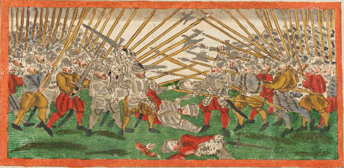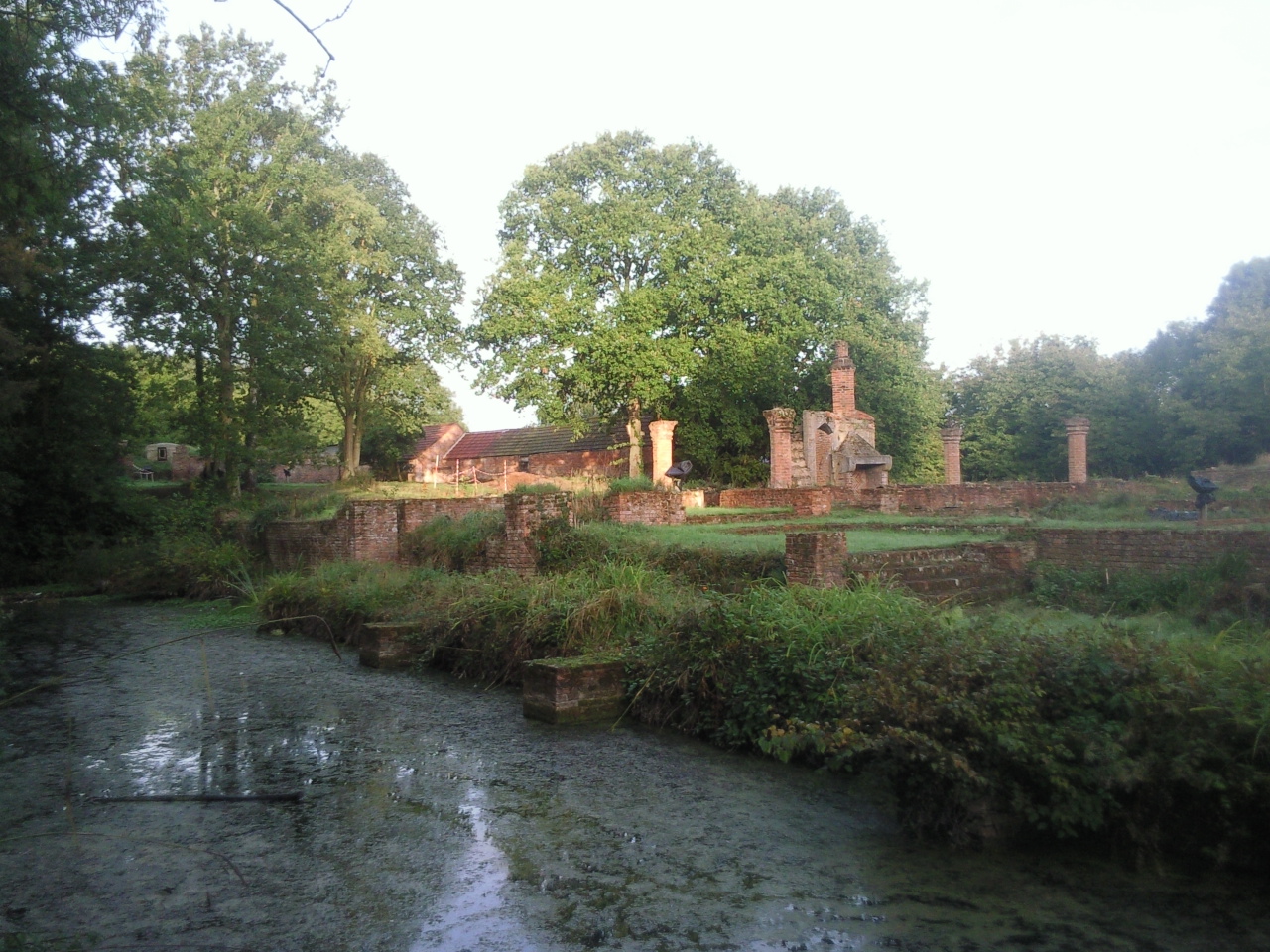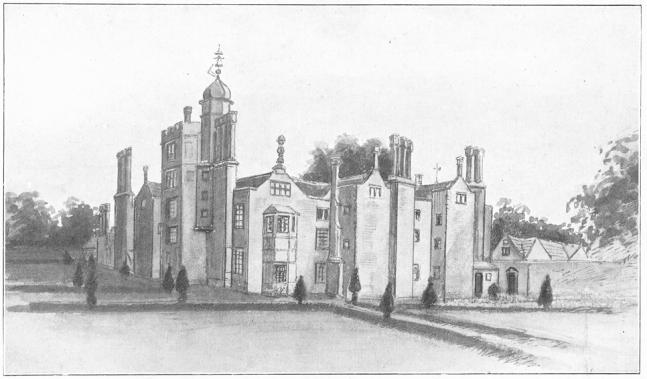|
Edward Habington
Edward Habington, Abington, or Abingdon (1553?–1586), was one of the conspirators in the plot formed by Anthony Babington. Habington was the eldest son of John Habington of Hindlip, Worcestershire, by his wife Catherine, daughter of John Wykes. Thomas Habington was a younger brother. His father held the office of under-treasurer or 'cofferer' to Queen Elizabeth. Born about 1553, Edward was educated at Exeter College, Oxford, where he took his bachelor's degree in 1574. On leaving the university he spent much time at court. He there made the acquaintance of Anthony Babington, a Catholic courtier, who early in 1586 was maturing, at the instigation of a Jesuit, a plan for a general rising of the Catholics which should accomplish the murder of the queen and the liberation of Mary Stuart, at that time imprisoned at Chartley. Habington not only joined Babington's conspiracy with other young frequenters of the court, but was named one of the six conspirators charged with the contempl ... [...More Info...] [...Related Items...] OR: [Wikipedia] [Google] [Baidu] |
Anthony Babington
Anthony Babington (24 October 156120 September 1586) was an English gentleman convicted of plotting the assassination of Elizabeth I of England and conspiring with the imprisoned Mary, Queen of Scots, for which he was hanged, drawn and quartered. The "Babington Plot" and Mary's involvement in it were the basis of the treason charges against her which led to her execution. He was a member of the Babington family. Biography Born into a gentry family to Sir Henry Babington and Mary Darcy, granddaughter of Thomas Darcy, 1st Baron Darcy de Darcy,Anthony Babington, Dictionary of National Biography (1895) . http://www.tudorplace.com.ar/Bios/AnthonyBabington.htm at Dethick Manor in Dethick, Derbyshire, England, he was their third child. His father died in 1571 when Anthony was nine years old, and his mother married Henry Foljambe. Anthony was under the guardianship of his mother, her second husband, Henry Foljambe, and Philip Draycot of Paynsley Hall, Cresswell, Staffordshire, his ... [...More Info...] [...Related Items...] OR: [Wikipedia] [Google] [Baidu] |
Worcestershire
Worcestershire ( , ; written abbreviation: Worcs) is a county in the West Midlands of England. The area that is now Worcestershire was absorbed into the unified Kingdom of England in 927, at which time it was constituted as a county (see History of Worcestershire). Over the centuries the county borders have been modified, but it was not until 1844 that substantial changes were made. Worcestershire was abolished as part of local government reforms in 1974, with its northern area becoming part of the West Midlands and the rest part of the county of Hereford and Worcester. In 1998 the county of Hereford and Worcester was abolished and Worcestershire was reconstituted, again without the West Midlands area. Location The county borders Herefordshire to the west, Shropshire to the north-west, Staffordshire only just to the north, West Midlands to the north and north-east, Warwickshire to the east and Gloucestershire to the south. The western border with Herefordshire includes a ... [...More Info...] [...Related Items...] OR: [Wikipedia] [Google] [Baidu] |
People Executed Under The Tudors For Treason Against England
A person ( : people) is a being that has certain capacities or attributes such as reason, morality, consciousness or self-consciousness, and being a part of a culturally established form of social relations such as kinship, ownership of property, or legal responsibility. The defining features of personhood and, consequently, what makes a person count as a person, differ widely among cultures and contexts. In addition to the question of personhood, of what makes a being count as a person to begin with, there are further questions about personal identity and self: both about what makes any particular person that particular person instead of another, and about what makes a person at one time the same person as they were or will be at another time despite any intervening changes. The plural form "people" is often used to refer to an entire nation or ethnic group (as in "a people"), and this was the original meaning of the word; it subsequently acquired its use as a plural form of per ... [...More Info...] [...Related Items...] OR: [Wikipedia] [Google] [Baidu] |
People Executed Under Elizabeth I By Hanging, Drawing And Quartering
A person ( : people) is a being that has certain capacities or attributes such as reason, morality, consciousness or self-consciousness, and being a part of a culturally established form of social relations such as kinship, ownership of property, or legal responsibility. The defining features of personhood and, consequently, what makes a person count as a person, differ widely among cultures and contexts. In addition to the question of personhood, of what makes a being count as a person to begin with, there are further questions about personal identity and self: both about what makes any particular person that particular person instead of another, and about what makes a person at one time the same person as they were or will be at another time despite any intervening changes. The plural form "people" is often used to refer to an entire nation or ethnic group (as in "a people"), and this was the original meaning of the word; it subsequently acquired its use as a plural form of ... [...More Info...] [...Related Items...] OR: [Wikipedia] [Google] [Baidu] |
1586 Deaths
Events * January 18 – The 7.9 1586 Tenshō earthquake, Tenshō earthquake strikes the Chubu region of Japan, triggering a tsunami and causing at least 8,000 deaths. * June 16 – The deposed and imprisoned Mary, Queen of Scots, recognizes Philip II of Spain as her heir. * July 6 – The Treaty of Berwick (1586), Treaty of Berwick is signed between Queen Elizabeth I of England and King James VI of Scotland. * July 21 – English explorer Thomas Cavendish begins the first deliberately planned Thomas Cavendish's circumnavigation, circumnavigation of the globe. * September 20–September 21, 21 – Execution of the Babington Plotters: The 14 men convicted of a plot (uncovered on July 17) to murder Queen Elizabeth and replace her with Mary, Queen of Scots, are hanged, drawn and quartered (the first seven being disembowelled before death) in St Giles Field, London. * September 22 – Battle of Zutphen: Spanish troops defeat the Dutch rebels and their Eng ... [...More Info...] [...Related Items...] OR: [Wikipedia] [Google] [Baidu] |
1550s Births
Year 155 ( CLV) was a common year starting on Tuesday (link will display the full calendar) of the Julian calendar. At the time, it was known as the Year of the Consulship of Severus and Rufinus (or, less frequently, year 908 ''Ab urbe condita''). The denomination 155 for this year has been used since the early medieval period, when the Anno Domini calendar era became the prevalent method in Europe for naming years. Births * Cao Cao, Chinese statesman and warlord (d. 220) * Dio Cassius, Roman historian (d. c. 235) * Tertullian, Roman Christian theologian (d. c. 240) * Sun Jian, Chinese general and warlord (d. 191) Deaths * Pius I, Roman bishop * Polycarp, bishop of Smyrna (b. AD 65 AD 65 ( LXV) was a common year starting on Tuesday (link will display the full calendar) of the Julian calendar. At the time, it was known as the Year of the Consulship of Nerva and Vestinus (or, less frequently, year 818 ''Ab urbe condita''). ...) References {{DEFAULTSORT:155 [...More Info...] [...Related Items...] OR: [Wikipedia] [Google] [Baidu] |
Alumni Of Exeter College, Oxford
Alumni (singular: alumnus (masculine) or alumna (feminine)) are former students of a school, college, or university who have either attended or graduated in some fashion from the institution. The feminine plural alumnae is sometimes used for groups of women. The word is Latin and means "one who is being (or has been) nourished". The term is not synonymous with "graduate"; one can be an alumnus without graduating ( Burt Reynolds, alumnus but not graduate of Florida State, is an example). The term is sometimes used to refer to a former employee or member of an organization, contributor, or inmate. Etymology The Latin noun ''alumnus'' means "foster son" or "pupil". It is derived from PIE ''*h₂el-'' (grow, nourish), and it is a variant of the Latin verb ''alere'' "to nourish".Merriam-Webster: alumnus .. Separate, but from the ... [...More Info...] [...Related Items...] OR: [Wikipedia] [Google] [Baidu] |
Hanged And Quartered
To be hanged, drawn and quartered became a statutory penalty for men convicted of high treason in the Kingdom of England from 1352 under King Edward III (1327–1377), although similar rituals are recorded during the reign of King Henry III (1216–1272). The convicted traitor was fastened to a hurdle, or wooden panel, and drawn by horse to the place of execution, where he was then hanged (almost to the point of death), emasculated, disembowelled, beheaded, and quartered (chopped into four pieces). His remains would then often be displayed in prominent places across the country, such as London Bridge, to serve as a warning of the fate of traitors. For reasons of public decency, women convicted of high treason were instead burned at the stake. The same punishment applied to traitors against the King in Ireland from the 15th century onward; William Overy was hanged, drawn and quartered by Lord Lieutenant Richard Plantagenet, 3rd Duke of York in 1469, and from the reign of King ... [...More Info...] [...Related Items...] OR: [Wikipedia] [Google] [Baidu] |
Edward VI
Edward VI (12 October 1537 – 6 July 1553) was King of England and Ireland from 28 January 1547 until his death in 1553. He was crowned on 20 February 1547 at the age of nine. Edward was the son of Henry VIII and Jane Seymour and the first English monarch to be raised as a Protestant. During his reign, the realm was governed by a regency council because he never reached maturity. The council was first led by his uncle Edward Seymour, 1st Duke of Somerset (1547–1549), and then by John Dudley, 1st Earl of Warwick (1550–1553), who from 1551 was Duke of Northumberland. Edward's reign was marked by economic problems and social unrest that in 1549 erupted into riot and rebellion. An expensive war with Scotland, at first successful, ended with military withdrawal from Scotland and Boulogne-sur-Mer in exchange for peace. The transformation of the Church of England into a recognisably Protestant body also occurred under Edward, who took great interest in religious matters. His fat ... [...More Info...] [...Related Items...] OR: [Wikipedia] [Google] [Baidu] |
Tower Of London
The Tower of London, officially His Majesty's Royal Palace and Fortress of the Tower of London, is a historic castle on the north bank of the River Thames in central London. It lies within the London Borough of Tower Hamlets, which is separated from the eastern edge of the square mile of the City of London by the open space known as Tower Hill. It was founded towards the end of 1066 as part of the Norman Conquest. The White Tower (Tower of London), White Tower, which gives the entire castle its name, was built by William the Conqueror in 1078 and was a resented symbol of oppression, inflicted upon London by the new Normans, Norman ruling class. The castle was also used as a prison from 1100 (Ranulf Flambard) until 1952 (Kray twins), although that was not its primary purpose. A grand palace early in its history, it served as a royal residence. As a whole, the Tower is a complex of several buildings set within two concentric rings of defensive walls and a moat. There were severa ... [...More Info...] [...Related Items...] OR: [Wikipedia] [Google] [Baidu] |
Francis Walsingham
Sir Francis Walsingham ( – 6 April 1590) was principal secretary to Queen Elizabeth I of England from 20 December 1573 until his death and is popularly remembered as her "spymaster". Born to a well-connected family of gentry, Walsingham attended Cambridge University and travelled in continental Europe before embarking on a career in law at the age of twenty. A committed Protestant, during the reign of the Catholic Queen Mary I of England he joined other expatriates in exile in Switzerland and northern Italy until Mary's death and the accession of her Protestant half-sister, Elizabeth. Walsingham rose from relative obscurity to become one of the small coterie who directed the Elizabethan state, overseeing foreign, domestic and religious policy. He served as English ambassador to France in the early 1570s and witnessed the St. Bartholomew's Day massacre. As principal secretary, he supported exploration, colonization, the use of England's maritime strength and the ... [...More Info...] [...Related Items...] OR: [Wikipedia] [Google] [Baidu] |
John Habington
John Habington or Abington (died 1581) was an English courtier and administrator. Career A son of Richard Habington and his wife Eleanor Hanley of Hanley William, John Habington's parental home was at Brockhampton near Bromyard in Herefordshire. Berwick-upon-Tweed Habington served the royal court in various administrative and financial roles. In October 1557 he was stationed at Berwick-upon-Tweed, involved in the supply of rations for the garrison and army. He was made Surveyor-General of the Victuals at Berwick. The Earl of Northumberland was pleased by the provisions for his house, but Habington discussed his resignation with the Privy Council in April 1559. This role of victualler at Berwick officially ended in November 1560, and Habington was instructed to give his accounts and the custody of storehouses at Berwick and Lindisfarne to Valentine Browne the new Surveyor General of Berwick. Browne had not arrived by 23 February 1561, when Habington wrote to William Cecil from Be ... [...More Info...] [...Related Items...] OR: [Wikipedia] [Google] [Baidu] |

_1938.jpg)






